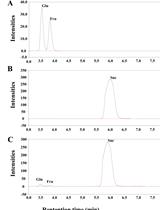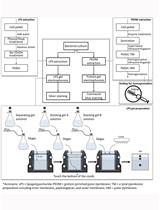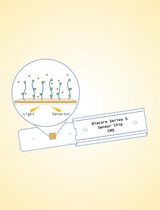- EN - English
- CN - 中文
Determination of Storage (Starch/Glycogen) and Total Saccharides Content in Algae and Cyanobacteria by a Phenol-Sulfuric Acid Method
苯酚-硫酸法测定藻类和蓝藻中淀粉/糖原的储存和总糖含量
发布: 2018年08月05日第8卷第15期 DOI: 10.21769/BioProtoc.2966 浏览次数: 12489
评审: Renate WeizbauerManish Kumar PatelDušan Veličković
Abstract
This is a protocol for quantitative determination of storage and total carbohydrates in algae and cyanobacteria. The protocol is simple, fast and sensitive and it requires only few standard chemicals. Great advantage of this protocol is that both storage and total saccharides can be determined in the cellular pellets that were already used for chlorophyll and carotenoids quantification. Since it is recommended to perform the pigments measurement in triplicates, each pigment analysis can generate samples for both total saccharide and glycogen/starch content quantification.
The protocol was applied for quantification of both storage and total carbohydrates in cyanobacteria Synechocystis sp. PCC 6803, Cyanothece sp. ATCC 51142 and Cyanobacterium sp. IPPAS B-1200. It was also applied for estimation of storage polysaccharides in Galdieria (IPPAS P-500, IPPAS P-507, IPPAS P-508, IPPAS P-513), Cyanidium caldarium IPPAS P-510, in green algae Chlorella sp. IPPAS C-1 and C-1210, Parachlorella kessleri IPPAS C-9, Nannochloris sp. C-1509, Coelastrella sp. IPPAS H-626, Haematococcus sp. IPPAS H-629 and H-239, and in Eustigmatos sp. IPPAS H-242 and IPPAS C-70.
Background
Carbohydrates play a number of roles in the metabolism of algae and cyanobacteria. As nicely summarized by Raven and Beardall (Raven and Beardall, 2003), carbohydrates represent major sink of intermediates in carbon reduction/oxidation pathways (photosynthesis and photorespiration), they provide skeletons required for growth (e.g., for amino-acid or cell wall biosynthesis), they represent sources of ATP and reducing equivalents (through respiration pathways), they serve as compatible solutes, they are essential for maintaining cellular turgor (by securing rigid structure of the cell wall) and they can scavenge free radicals. Storage polysaccharides (of which the main forms in algae and cyanobacteria are starch and glycogen) that serve as both energy and carbon source, buffer the disproportion between the carbohydrates production and consumption rates, and allow for active metabolism (e.g., nitrogen fixation) in the dark periods.
Carbohydrates are routinely analyzed in many life science laboratories. The saccharides content can be quantified by a wide range of chemical (e.g., chromatographic), biochemical (e.g. gravimetric, colorimetric, enzymatic) or physical (e.g., polarimetry) methods. The estimation of storage carbohydrates as described in this protocol represents a combination of starch/glycogen purification according to the previous studies (Schneegurt et al., 1994; Bandyopadhyay et al., 2010; Sinetova et al., 2012), starch/glycogen decomposition in acidic environment and free glucose determination by the classical phenol-sulfuric acid method (Dubois et al., 1956; Masuko et al., 2005). Total carbohydrates estimation consists of simple resuspension of the cellular pellet (after extraction of chlorophyll and carotenoids) in phenol solution and hydrolyzation of cellular saccharides by sulfuric acid.
The advantages of this protocol are simplicity, sensitivity and quickness. The carbohydrates/glycogen/starch estimation requires only several standard reagents, which makes this protocol much simpler and cheaper when compared to protocols that include enzymatic cleavage of glycogen (De Porcellinis et al., 2017; Khan et al., 2018), enzymatic determination of free glucose (Bandyopadhyay et al., 2010; Sinetova et al., 2012; Khan et al., 2018) or extensive amounts of chemicals (Khan et al., 2018). Another advantage of this protocol is that only 1 ml of diluted culture suspension is needed for the analysis (for further details see Note 1) which is significantly lower amount than required in other protocols (De Porcellinis et al., 2017). Additionally, saccharides/glycogen/starch measurement can be performed on the same samples that were originally used for determination of chlorophyll and carotenoids content (Sinetova et al., 2012).
On the other hand, this protocol is not as specific for determination of storage polysaccharides as the enzymatic assays (De Porcellinis et al., 2017) since glycogen or starch are distinguished only partially from other cellular polysaccharides (e.g., from polysaccharides of the cell wall). Another limitation is using D-glucose as a calibration standard since various carbohydrates that are present in the cells differ in the absorption spectra (Dubois et al., 1956; Masuko et al., 2005). Nevertheless, even with these limitations, this cheap, simple and fast protocol is suitable for rough estimation of carbohydrates content in algae and cyanobacteria.
Materials and Reagents
- Safe-lock tubes 1.5 ml SafeSeal (SARSTEDT, catalog number: 72.706.400 )
- Rotilabo® Sealing clips for the safe-lock tubes tubes (Carl Roth, catalog number: N217.1 )
- Holders for the safe-lock tubes (VWR, catalog number: 30128-282 )
- 96-well microplates (type P) with the original lids (Cole-Parmer, catalog numbers: EW-07903-80 and EW-07903-86 )
- Pipette tips
- Reservoir for a multichannel pipette 60 ml (BrandTech Scientific, catalog number: 703459 )
- Aluminum foil (optional)
- Cyanobacterial/algae culture
- Methanol ≥ 99.9% (Alfa Aesar, catalog number: 41467.K7 )
- Phenol (Sigma-Aldrich, catalog number: P1037 )
- Potassium hydroxide p.a. (Ing. Petr Švec - PENTA, catalog number: 15520-31000 )
- Ethanol 96% (Merck, catalog number: 1590102500 )
- Sulfuric acid 96% (Ing. Petr Švec - PENTA, catalog number: 20370-11000 )
- D-glucose (Sigma-Aldrich, catalog number: G8270 )
- Distilled/double deionized water
- Sodium hydroxide (Ing. Petr Švec - PENTA, catalog number: 15760-31000 )
- Hydrochloric acid (Ing. Petr Švec - PENTA, catalog number: 19360-11000 )
- Glucose calibration series (see Recipes)
Equipment
- Pipettes
- Fridge 4 °C, freezer -20 °C (LIEBHERR, model: LCexv 4010 , catalog number: 9005382197172), optionally -80 °C (RevcoTM ExF -86 °C Upright Ultra-Low Temperature Freezer, Thermo Fisher Scientific, catalog number: EXF24086V )
- Fume hood (MERCI, model: M 1500 , catalog number: 2D100110200001)
- Refrigerated centrifuge (Sigma Laborzentrifugen, model: Sigma 1-16K , catalog number: 10030)
- Vacuum Concentrator (Eppendorf, model: Concentrator plus , catalog number: 5305000100)
- Analytical balances with an accuracy of 10 μg (Sartorius, catalog number: SECURA225D-1OBR )
- Microplate spectrophotometer (Thermo Fisher Scientific, model: MultiskanTM GO , catalog number: 51119300)
Procedure
文章信息
版权信息
© 2018 The Authors; exclusive licensee Bio-protocol LLC.
如何引用
Zavřel, T., Očenášová, P., Sinetova, M. A. and Červený, J. (2018). Determination of Storage (Starch/Glycogen) and Total Saccharides Content in Algae and Cyanobacteria by a Phenol-Sulfuric Acid Method. Bio-protocol 8(15): e2966. DOI: 10.21769/BioProtoc.2966.
分类
微生物学 > 微生物生物化学 > 糖类
植物科学 > 藻类学 > 细胞分析
生物化学 > 糖类 > 糖原
您对这篇实验方法有问题吗?
在此处发布您的问题,我们将邀请本文作者来回答。同时,我们会将您的问题发布到Bio-protocol Exchange,以便寻求社区成员的帮助。
Share
Bluesky
X
Copy link












